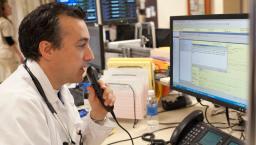EHR documentation burdens increasing with virtual care expansion, says study

Photo: Reza Estakhrian/Getty
A new study published in the Journal of the American Medical Association Network compared patient messaging among ambulatory physicians before and after the onset of the COVID-19 pandemic, and found the physicians were mostly documenting visits and not messaging patients.
WHY IT MATTERS
The study proposed that if telemedicine expansion indicates physicians spending more overall time in EHRs, health systems and policymakers may need to alter productivity expectations and their reimbursement policies.
The researchers from the Division of Clinical Informatics and Digital Transformation in the Department of Medicine at the University of California, San Francisco, and the American Medical Association studied the documentation activity of 1,052 ambulatory physicians at UCSF Health over 115 weeks straddling the onset of the COVID-19 pandemic.
Their multivariable regression model analyzed weekly EHR metadata, comparing the same measures for one year before the pandemic – August 2018-September 2019 – with the same period one year after its onset – August 2020-September 2021.
They found that physician time spent working in the EHR during patient scheduled hours increased from 4.53 to 5.46 hours per eight patient scheduled hours.
Outside of PSHs, their time spent documenting in the EHR increased from 4.29 to 5.34 hours.
The overall time ambulatory physicians spent documenting in EHRs – during and outside of PSHs – increased from 6.35 before the pandemic to 8.18 hours in September 2021, according to the study.
Weeks with a mix of face-to-face and telemedicine visits or entirely telemedicine had more EHR time during PSHs than all face-to-face weeks, with similar results for EHR time outside of PSHs, the researchers said.
"Health systems may need to adjust productivity expectations for physicians and develop strategies to address EHR documentation burden for physicians," they concluded.
THE LARGER TREND
In the throes of the pandemic, the study's primary author, A. Jay Holmgren at UCSF, previously partnered with other researchers from Stanford, Harvard and other universities who suspected the rise of telehealth could be to blame for spiking the amount of time clinicians were spending in the EHR.
Their 2021 Journal of the American Medical Informatics Association study, which looked at the EHR metadata from ambulatory care clinicians in 366 U.S. health systems using Epic from December 2019 to December 2020, found that in-basket messages and clinical review were two major factors driving daily EHR minutes up.
"Policymakers and health system leaders should keep these new demands on clinician time in mind as they develop future reimbursement models and workflows, taking care not to exacerbate EHR-driven clinician burnout," those researchers said in JAMIA.
More recently, Epic looked at telehealth data to determine the efficacy of virtual care and make the case for further reimbursement.
Across 35 million telehealth visits between March 1, 2020 and May 31, 2022, most patients did not require in-person visits within 90 days of online appointments, the EHR vendor's researchers said.
They said the results of this analysis of Epic's data indicated that virtual visits are an effective "alternative, rather than duplicative" care modality and that because telehealth increases access to care, "payers should extend telehealth visit coverage" beyond the pandemic waiver.
While the telehealth waiver has been extended for two years in the 2022 Omnibus, the Telehealth Expansion Act of 2023 allows citizens with high-deductible health plans and health savings accounts access to telehealth and other remote care services permanently, without having to meet their minimum deductible first.
"The expansion allows for people to start the cycle of primary care treatment and follow up on other treatment options that their doctor or primary provider has recommended for them, without having to worry about high costs, deductibles or transportation issues," Kamala Green, social drivers of health program manager at National Government Services, told Healthcare IT News in August.
ON THE RECORD
"Understanding the drivers of [EHR] burden, including EHR time and patient messaging, may directly inform strategies to address physician burnout," said researchers. "Given the COVID-19−induced expansion of telemedicine – now used for a substantial proportion of ambulatory encounters – its association with EHR burden should be evaluated."
Andrea Fox is senior editor of Healthcare IT News.
Email: afox@himss.org
Healthcare IT News is a HIMSS Media publication.
























